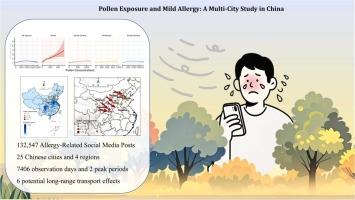花粉暴露与轻度过敏:中国多城市研究
IF 11.3
1区 环境科学与生态学
Q1 ENGINEERING, ENVIRONMENTAL
引用次数: 0
摘要
花粉暴露是过敏性疾病的一个关键触发因素,然而有限的监测和轻微的症状阻碍了常规监测捕捉其直接影响。该研究利用社交媒体数据,探索了2022年5月至2023年12月期间中国大陆25个城市的花粉暴露与过敏相关帖子之间的实时联系。从监测数据中获取花粉水平,并通过两阶段爬行法收集微博上每日与过敏相关的帖子,并用机器学习进行分类。使用广义线性模型估计城市特定效应,并通过元回归进行汇总。平均日花粉浓度为127.66粒/10³mm²。花粉每增加10粒/10³mm²,过敏风险增加0.3% (RR: 1.003; 95% CI: 1.002, 1.004)。上呼吸道症状的相关性最强(RR: 1.010; 95% CI: 1.007, 1.014),其次是下呼吸道症状(RR: 1.004; 95% CI: 0.999, 1.009)和皮肤症状(RR: 1.001; 95% CI: 1.000, 1.002)。影响在较长的滞后期内减弱,在北方城市和秋季高峰期间最强。通过整合社交媒体和环境数据,本研究及时提供了花粉短期影响的证据,强调了针对特定地区和季节的公共卫生策略的必要性。本文章由计算机程序翻译,如有差异,请以英文原文为准。

Pollen Exposure and Mild Allergy: A Multi-City Study in China
Pollen exposure is a key trigger for allergic diseases, yet limited monitoring and mild symptoms hinder conventional surveillance from capturing its immediate impact. This study used social media data to explore real-time links between pollen exposure and allergy-related posts in 25 mainland Chinese cities from May 2022 to December 2023. Pollen levels were obtained from monitoring data, and daily allergy-related posts on Weibo were collected via a two-stage crawling method and classified with machine learning. City-specific effects were estimated using generalized linear models, and pooled via meta-regression. The average daily pollen concentration was 127.66 grains/10³ mm². Each 10 grains/10³ mm² increase in pollen was associated with a 0.3% (RR: 1.003; 95% CI: 1.002, 1.004) higher risk of allergies. The strongest associations were observed for upper respiratory tract symptoms (RR: 1.010; 95% CI: 1.007, 1.014), followed by lower respiratory tract symptoms (RR: 1.004; 95% CI: 0.999, 1.009) and dermatologic symptoms (RR: 1.001; 95% CI: 1.000, 1.002). Effects declined over longer lag periods and were strongest in northern cities and during autumn peaks. By integrating social media and environmental data, this study provides timely evidence of pollen’s short-term impacts, highlighting the need for region- and season-specific public health strategies.
求助全文
通过发布文献求助,成功后即可免费获取论文全文。
去求助
来源期刊

Journal of Hazardous Materials
工程技术-工程:环境
CiteScore
25.40
自引率
5.90%
发文量
3059
审稿时长
58 days
期刊介绍:
The Journal of Hazardous Materials serves as a global platform for promoting cutting-edge research in the field of Environmental Science and Engineering. Our publication features a wide range of articles, including full-length research papers, review articles, and perspectives, with the aim of enhancing our understanding of the dangers and risks associated with various materials concerning public health and the environment. It is important to note that the term "environmental contaminants" refers specifically to substances that pose hazardous effects through contamination, while excluding those that do not have such impacts on the environment or human health. Moreover, we emphasize the distinction between wastes and hazardous materials in order to provide further clarity on the scope of the journal. We have a keen interest in exploring specific compounds and microbial agents that have adverse effects on the environment.
 求助内容:
求助内容: 应助结果提醒方式:
应助结果提醒方式:


